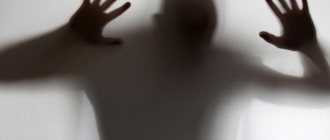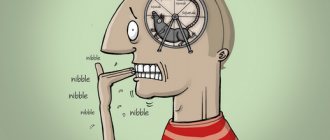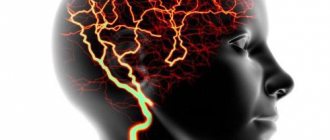OCD symptoms
You can suspect obsessive-compulsive disorder in yourself or your loved ones based on the following signs.
- Scrolling negative thoughts and images in your head. Patients are often tormented by thoughts of death, violence, sexual perversion, immoral and antisocial acts. These images are emotionally charged and extremely intrusive. A person tries with all his might to suppress or drive them away, but, as a rule, fails. Over time, he develops a fear of these thoughts.
- The emergence of irrational anxiety. Feelings of anxiety can arise out of nowhere without any threat. The patient can neither explain the cause of its occurrence nor cope with it on his own.
- Repetitive actions or rituals. Clicking your fingers, monotonously repeating words or phrases, the aforementioned hand washing... There are many options. These actions are performed at the moment of anxiety and are often unconscious.
- Avoiding crowded places. People with OCD feel uncomfortable in crowded places. In a crowd, their anxiety intensifies to the point of developing panic attacks. They prefer quiet solitude to noisy gatherings in company.
- Tendency to constantly double-check everything. Those suffering from obsessive-compulsive disorder can check ten times whether the gas or iron is turned off. They are constantly tormented by the worry that they forgot to take or do something. It's like they don't trust themselves.
- Hoarding. Patients have difficulty parting with old and unnecessary things. Attempts to get rid of junk are accompanied by outbreaks of anxiety. A person keeps things “just in case,” in the hope that they will come in handy someday.
- Obsessive counting. The habit of constantly counting something is characteristic of OCD. Sometimes the most unexpected things can be counted. For example, spots on the fur of a neighbor’s dog, the letter “m” on signs and shop windows, peas in a plate of salad.
- Unhealthy pedantry. This symptom can be expressed in constant cleaning and arranging things in their places. Any deviation from the established order causes psychological discomfort.
Forms of the disease
Obsessive-compulsive neurosis manifests itself in 2 main forms – obsessions and compulsions.
Obsessions are annoying thoughts that regularly visit a person. However, he cannot control them or get them out of his head. In one case, they are periodic and do not overly absorb a person’s consciousness, in the other, they terrorize him almost all the time. At the same time, the person tries hard to overcome them, to get them out of his head, but nothing comes of it.
For example, a girl is overcome by the idea that she might be seduced by a woman and become a lesbian. Because of this, she tries not to let women touch her.
Such obsessions manifest themselves in several categories:
- doubts. In this case, the patient constantly questions his actions and seeks confirmation of their correctness in everything. At work, while fulfilling his duties, he asks to be rechecked. When leaving the house, he returns several times to make sure that the gas is closed;
- fear. A person is afraid that he will not be able to perform any action correctly or will do something dangerous for him. This includes fear of public speaking;
- attractions. A person's desire to commit an obscene or dangerous act. For example, when a passionately loving mother has a pathological desire to kill her child. Or a respectable, moral girl has a super-urge to commit depraved acts. The peculiarity of such drives is that they are never realized;
- memories. Images of a past event, lyrics of a song, phrase, etc. constantly pop up in a person’s mind;
- thoughts. Implausible thoughts about an important event that has happened. This often happens to parents who have lost a child. Disbelief that he was dead or the belief that he was buried alive may prompt them to exhume the body.
Obsessions also include meaningless philosophizing. This is a process of fruitless thinking, without specific goals and results. For example, while walking down the street, a person may reason about whether a red car will pass by. If so, what shade will it be: light or dark? Where she is going, will she turn or go straight. How many people will be in the car, what brand will it be, etc.
Such philosophizing differs from reasoning in the critical attitude of the patient himself to it.
Some experts also include phobias in this group - a pronounced, hypertrophied fear of something. The most common:
- cancerophobia – fear of getting cancer;
- Cardiophobia – heart disease;
- algophobia – fear of pain;
- thanatophobia – fear of death;
- nyctophobia – fear of the dark;
- phobophobia – fear of fear;
- Panophobia is the fear of everything in the world.
Obsessions do not affect the patient’s logical thinking. In addition, some try to fight such obsessive thoughts. In case of active opposition, a person can take actions in defiance of obsessive thoughts. If he has doubts about a locked door and is tempted to go back and double-check it, he deliberately does not return and follows in the designated direction.
In case of passive opposition, a person tries to switch to other thoughts or actions.
Compulsions are obsessive actions that appear regardless of a person’s will. At the same time, he is accompanied by an irrepressible desire to perform them repeatedly in such a way that they acquire the character of a ritual. If the patient tries to refuse to commit them, then he develops anxiety and a feeling of fear. They will accompany him until the person completes the ritual.
The girl is forced to press the switch 3 times. At the same time, she is sure that if she stops doing this, something terrible will happen.
Examples of compulsions also include pathological overeating, excessive exercise - several hours several times a day, and by fairly slim people whose physical form does not require it. They play sports so much because they simply have an irresistible need for it. Having completed the ritual, they calm down, but the next day the impulse to train returns.
Workaholism, the need to constantly do some kind of work and not sit idle, is also classified as compulsions.
Obsessive actions can visit a person in one instance, or can be combined in several forms. Thus, there is a well-known story of one girl whose obsessive-compulsive disorder first appeared at the age of 10. It all started with a craving for symmetry, to achieve which she cut her eyelashes repeatedly. Then came the need to count steps, wash hands many times, and avoid cracks in the road. Gradually, self-traumatic rituals were added: cutting, burning, etc.
But most often, compulsions and obsessions occur simultaneously, forming obsessive-compulsive disorder.
It all starts with the emergence of an obsessive, frightening thought. For example, about the accumulation of pathogenic bacteria on the hands, which can cause a terrible, fatal illness. A person is looking for a way out of the situation, how to avoid this. He begins to wash his hands, and not like a normal person: before eating, when he comes home from the street, and several more times between “normal” washings. Several dozen times. But it’s not just the banal thing of washing your hands with soap.
Before performing the ritual, a person decides how many times he should soap his hands. 2 times 3 sets, but not 3 times. 3 is the Holy Trinity, there is no need to involve it in such a banal matter. Then it’s better to do 5 times 5 repetitions. He lathers his hands 5 times, rinses and repeats the action 4 more times. This brings relief for a while, but soon the annoying thought arises again. And the person begins to wash his hands again a certain number of times. At the same time, he understands the absurdity of the situation, but is unable to refuse it.
Causes of obsessive-compulsive disorder
The development of this neurosis is facilitated by both biological, psychological and social factors. Biological factors include:
- traumatic brain injuries;
- past infectious diseases of the brain: encephalitis, meningitis;
- disruption of biochemical processes in the brain;
- chemical addictions;
- heredity;
- mental illness;
- weak nervous system.
Psychological reasons for the development of OCD:
- prolonged and severe stress;
- increased parental control in childhood;
- experienced fear in connection with a threat to life;
- moral and physical violence;
- death of loved ones;
- excessive religiosity.
It is worth noting that obsessive-compulsive personality disorder affects people with a certain type of character. These are mainly anxious, insecure individuals with low self-esteem. They tend to constantly doubt everything and look for support in stronger and more confident people. Very often they remain over-aged infantiles and live under someone else's care until old age. This is partly facilitated by progressive neurosis.
These individuals are poorly adapted to society and have very low resistance to stress. Their weak nervous system is not able to cope with difficulties and malfunctions.
Treatment of OCD
OCD cannot be ignored, even if its manifestations are not yet very pronounced. This disorder tends to progress and get worse. Over time, obsessive thoughts become more and more numerous, and rituals help cope with them less and less.
Severe OCD is difficult to treat. About 1% of patients commit suicide, more than 10% lose their ability to work. The less time has passed from the first manifestations of the disease to contacting a psychotherapist, the more favorable the prognosis.
OCD is treated with pharmacological drugs and psychotherapy.
Drug treatment
Medicine has taken care to make the life of a person suffering from OCD easier. The purpose of using medications is to relieve symptoms and return the patient to normal life. But it is impossible to cure this disorder with pills alone. After stopping their use, all symptoms usually return. Therefore, drug therapy must necessarily be accompanied by treatment from a psychotherapist or psychiatrist.
For OCD, antidepressants, tranquilizers and antipsychotics are prescribed. Antidepressants restore the balance of serotonin, adrenaline and norepinephrine in the brain. Tranquilizers relieve anxiety. And antipsychotics reduce psychomotor agitation.
These are very serious drugs with a lot of side effects, so only a doctor can prescribe them.
Psychotherapeutic treatment
When correcting OCD, the exposure and bias method has proven itself to be the best. The patient is placed in conditions that cause obsessive thoughts, without giving him the opportunity to resort to compulsive actions. The specialist teaches the patient constructive methods of reducing anxiety and getting rid of obsessions.
In cognitive behavioral therapy, fears and anxieties are brought to a conscious level and processed. The psychotherapist helps the patient isolate the unconscious component of his obsessions and rationalize it.
The aversive method helps the patient give up compulsions, reinforcing the unpleasant associations associated with them.
In extreme cases, the doctor resorts to hypnosis. With its help, it is possible to break the pathological connection between obsessions and compulsions, bypassing consciousness.
Unfortunately, even after successful treatment there is a high risk of relapse. The disease becomes chronic, dormant, and can awaken again at any moment. Therefore, it is very important to maintain psychological hygiene. Patients should avoid stress, do not overwork, and do not abuse alcohol.
Tip 3: Lifestyle Changes
A healthy, balanced lifestyle plays a big role in reducing anxiety and controlling OCD, fears, and worries.
Exercise regularly
Exercise is a natural and effective treatment that helps control OCD symptoms. They refocus the mind when obsessive thoughts and compulsions arise. For maximum benefit, try getting 30 minutes or more of aerobic activity per week. Ten minutes several times a day can be just as effective as a longer period, especially if you pay attention to the process of movement.
Find out more What is withdrawal syndrome and how is it treated
Get enough sleep
Not only does anxiety cause insomnia, but lack of sleep aggravates anxious thoughts and feelings. When you're well-rested, it's much easier to maintain your emotional balance—a key factor in managing anxiety disorders like OCD.
Avoid alcohol and nicotine
Alcohol temporarily reduces anxiety, but actually causes symptoms of anxiety when its effects wear off. In the same way that cigarettes seem to calm you down, nicotine is actually a powerful stimulant. Smoking leads to higher levels of anxiety and OCD symptoms.
Practice relaxation techniques
Although stress does not cause OCD, it can trigger or worsen symptoms. Meditation, yoga, deep breathing, and other relaxation techniques will help reduce your overall level of stress and tension and help you cope with urges. For best results, practice relaxation techniques regularly.
Helpful Resources for People with OCD
I return to Wikium, which I mentioned at the beginning of my article. I hope you have already visited the site, worked out on cool exercise machines, and added several of them to your bookmarks. In this block I will recommend several courses to you; I think they will be no less useful.
Brain fitness
Description. Eight of my readers bought this course. There were no negative reviews, everyone was happy. It is very expensive, but I always recommend it, and I put it first.
When you purchase Brain Fitness, the Wikium developers send you by mail a small device called a “neural interface”. This is an amazing thing that analyzes the electromagnetic waves coming from your brain. Look at the guy in the picture - he has a neural interface on his head.
The read fluctuations are then sent to the Vikium platform, where they are analyzed automatically. The analysis takes place in your personal account, when it is completed, you receive recommendations - what is wrong with your head, what should be done with it at the moment, and so on.
The device should be used when you are experiencing different emotional states. When you feel relaxed, or tense, depressed, when you are afraid or cannot get obsessive thoughts out of your head. Use the neural interface and compare the results.
The course itself is aimed at your personal development, getting rid of negativity and transitioning to an optimistic worldview. If you want, you can buy the neural interface separately, but I advise you not to give up the training program, it’s more effective.
Authors: developers of the Vikium project.
Cost: 12,990 rub.
Find out more and sign up for training
Brain Detoxification
Description . This course is already ten times cheaper, there is no neural interface here. In ten lessons, the teacher will teach you how to get rid of all the negativity in your head. From any negative and obsessive thoughts, bad memories, anxiety, fear, worries and so on.
There is a lot of practice in this course. You master the theory and begin training on specially designed exercises, as well as simulators from Vikium.
After paying for it, you will download all course materials to your PC, so they won’t go anywhere. If you want to ask questions or something is unclear to you, the teacher is in touch.
The simulators themselves are very exciting, they give you the opportunity to relax and unwind.
Authors: developers of the Vikium project.
Cost: 1,490 rub.
Find out more and sign up for training
Emotional intellect
Description. I also recommend that you take the emotional intelligence course. Understand the emotions (your own and those around you), learn to manage them better. Essentially, OCD occurs because the mind is unable to gain control over emotions. Negative thoughts are spinning in your head because you are driven by fear, anger, envy or various other feelings.
The theory in this material is packed into twenty lessons, you will go through them very quickly. There are exercises and simulators to develop practical skills.
The course will not only help you cope with panic attacks more easily or get out of OCD completely, but will also make it easier to communicate with people around you, teach you how to react correctly to their actions, etc.
Authors: developers of the Vikium project.
Cost: 1,490 rub.
Find out more and sign up for training
If you know of other good courses for people with OCD, or maybe you have attended webinars on this topic, read books that helped you come to your senses, tell us about them in the comments. I will supplement my article with your recommendations.











